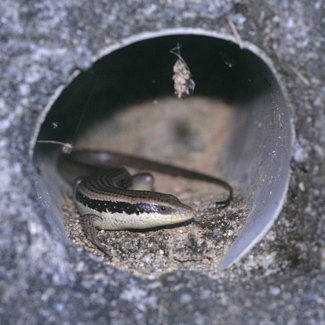Urban lizards worse off with climate change

LIZARDS HAVE LONG BEEN drawn to warmer man-made habitats to nest their eggs, but new research has revealed that climate change is making temperatures too high for babies to hatch in these urban environments.
The findings suggest that lizards need to head back to their natural habitats if they are to survive.
For the last 10 years Dr David Pike, herpetologist from James Cook University, and colleague Dr Wen-San Huang from Taiwan’s National Museum of Natural Science have studied the long-tailed skink, (Eutropis longicaudata), on Orchid Island off the coast of Taiwan. The species is found widely across South East Asia.
“When we started this work over a decade ago, the concrete wall was by far the best nesting site,” David says. “Many types of lizards are used to these areas being good for them.”
Nests built in snug man-made materials previously produced baby skinks that were larger, grew faster, and survived better than their counterparts born in a natural habitat, he says. But as the temperatures increased, fewer baby lizards survived in human-modified environments, and many eggs didn’t hatch at all, the researchers found.
Lizards on the move
“By creating the concrete wall, humans initially provided an excellent nesting site for lizards, but human-induced climate change has caused this habitat to no longer be suitable for nesting,” David says. The results, published this month in the journal Functional Ecology, suggest the eggs are more likely to survive rising temperatures if skinks return to nesting in a natural environment.
The researchers are holding their breath to see if the skinks in urban habitats will respond to the heat and choose more temperate places to lay their eggs in the future. Females often instinctively seek out the best places to lay eggs in a natural environment, but whether they will adapt in an urban setting remains an open question. “The females are good at choosing nest sites, and we’re not sure how they do that,” says David. “But if they’re always choosing the hottest area, then they’ll die out.”
The female skinks on Orchid Island are also fiercely protective of their eggs. Man-made materials offer scant protection from the large population of egg-eating snakes on the island, and researchers fear this unique maternal behaviour could change if the eggs aren’t hatching.
Coping with climate change
While the research poses questions about the future of urban-dwelling skinks on Orchid Island, David says the species is not in danger of extinction. There are concerns, however, for the survival of less common lizard species facing similar challenges. “We’re getting a glimpse of what is going to be happening in natural environments worldwide,” he says.
Dr Arthur Georges, a herpertologist from the University of Canberra, says the study sends a powerful message about how the complex interaction between wildlife, climate change and habitats is going to play out. “What it shows is that you can look at a species in a modified habitat as having better reproductive success, but in the long haul that success may be ephemeral and doesn’t last,” he says.
Arthur says animal species have always been able to cope with vast changes in their own environments. There need to be further studies carried out over time. he says, to determine how modified habitats may affect this adaptability in the context of climate change.
RELATED STORIES




